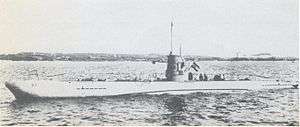German submarine U-6 (1935)
 U-1, the first Type II boat | |
| History | |
|---|---|
| Name: | U-6 |
| Ordered: | 2 February 1935 |
| Builder: | Deutsche Werke, Kiel |
| Cost: | 1,500,000 Reichsmark |
| Yard number: | 241 |
| Laid down: | 11 February 1935 |
| Launched: | 15 June 1935 |
| Commissioned: | 29 June 1935 |
| Decommissioned: | 7 August 1944 at Gotenhafen |
| General characteristics | |
| Class and type: | IIA coastal submarine |
| Displacement: |
|
| Length: |
|
| Beam: |
|
| Height: | 8.60 m (28 ft 3 in) |
| Draught: | 3.83 m (12 ft 7 in) |
| Installed power: |
|
| Propulsion: |
|
| Range: |
|
| Test depth: | 80 m (260 ft) |
| Complement: | 3 officers, 22 men |
| Armament: |
|
| Service record | |
| Part of: |
|
| Identification codes: | M 00 130 |
| Commanders: |
|
| Operations: | Two patrols |
| Victories: | No ships sunk or damaged |
The German submarine U-6 was a long-lived but very inactive Type IIA U-boat built before World War II for service in Nazi Germany's Kriegsmarine.
As she was one of the first batch of boats built following the renunciation of the Treaty of Versailles, she was capable of only coastal and short cruising work. This led to her being reassigned to training duties after the Norwegian campaign in 1940.
Design
German Type II submarines were based on the Finnish submarine Vesikko. U-6 had a displacement of 254 tonnes (250 long tons) when at the surface and 303 tonnes (298 long tons) while submerged. Officially, the standard tonnage was 250 long tons (250 t), however.[2] The U-boat had a total length of 40.90 m (134 ft 2 in), a pressure hull length of 27.80 m (91 ft 2 in), a beam of 4.08 m (13 ft 5 in), a height of 8.60 m (28 ft 3 in), and a draught of 3.83 m (12 ft 7 in). The submarine was powered by two MWM RS 127 S four-stroke, six-cylinder diesel engines of 700 metric horsepower (510 kW; 690 shp) for cruising, two Siemens-Schuckert PG VV 322/36 double-acting electric motors producing a total of 360 metric horsepower (260 kW; 360 shp) for use while submerged. She had two shafts and two 0.85 m (3 ft) propellers. The boat was capable of operating at depths of up to 80–150 metres (260–490 ft).[2]
The submarine had a maximum surface speed of 13 knots (24 km/h; 15 mph) and a maximum submerged speed of 6.9 knots (12.8 km/h; 7.9 mph).[2] When submerged, the boat could operate for 35 nautical miles (65 km; 40 mi) at 4 knots (7.4 km/h; 4.6 mph); when surfaced, she could travel 1,600 nautical miles (3,000 km; 1,800 mi) at 8 knots (15 km/h; 9.2 mph). U-6 was fitted with three 53.3 cm (21 in) torpedo tubes at the bow, five torpedoes or up to twelve Type A torpedo mines, and a 2 cm (0.79 in) anti-aircraft gun. The boat had a complement of 25.[2]
Service history
Built at Kiel in 1935, U-6 was a prestigious position for a captain in the Kriegsmarine during the years running up to the war, her commanders were all First World War veterans. However, once war began, it was painfully clear that U-6 and her sisters were not capable of competing with other nations' larger and faster boats, and so after an initial patrol in the Baltic Sea, U-6 was not deployed again until March 1940, when every ship available to the Kriegsmarine was sent to support the invasion of Norway. During the month-long campaign, U-6's sister boats suffered numerous losses, and gained a reputation as something of a liability, which led them to be withdrawn to a training squadron in the Baltic for the remainder of the war.
In the Baltic, U-6 trained officer cadets in the skills needed to fight in the Battle of the Atlantic. Some of her patrols even verged on Soviet territory following Operation Barbarossa but, unlike some of her sister boats, U-6 never found a target on these missions. In the summer of 1944, with fuel and resources in short supply and the reputation of the Type II boats plummeting following a number of fatal accidents, U-6 was removed from service and laid up at Gotenhafen with a skeleton crew to perform maintenance. There she remained until May 1945, when a demolition team blew her up at her berth to prevent her falling into enemy hands.
References
- ↑ Busch & Röll 1999, p. 283.
- 1 2 3 4 Gröner 1991, pp. 39–40.
Bibliography
- Busch, Rainer; Röll, Hans-Joachim (1999). German U-boat commanders of World War II : a biographical dictionary. Translated by Brooks, Geoffrey. London, Annapolis, Md: Greenhill Books, Naval Institute Press. ISBN 1-55750-186-6.
- Gröner, Erich; Jung, Dieter; Maass, Martin (1991). U-boats and Mine Warfare Vessels. German Warships 1815–1945. 2. Translated by Thomas, Keith; Magowan, Rachel. London: Conway Maritime Press. ISBN 0-85177-593-4.
- Sharpe, Peter (1998). U-Boat Fact File. Great Britain: Midland Publishing. ISBN 1-85780-072-9.
External links
- Helgason, Guðmundur. "The Type IIA boat U-6". German U-boats of WWII - uboat.net. Retrieved 6 December 2014.
- Hofmann, Markus. "U 6". Deutsche U-Boote 1935-1945 - u-boot-archiv.de (in German). Retrieved 18 December 2015.